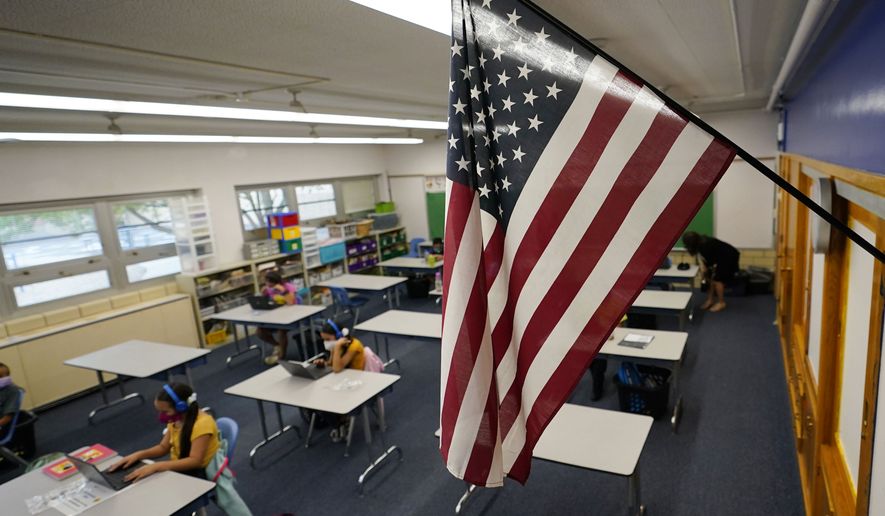Maybe, with all the focus on exposing students to hot-button cultural issues, there’s just no room in the modern American classroom for lessons on Flag Day, the annual celebration of the history of the Stars and Stripes.
A study says more than 30% of children don’t know the American flag has 50 stars representing the nation’s 50 states.
The survey, released by the homework learning platform Brainly ahead of the holiday Tuesday, also finds that 53.2% of middle and high school students do not discuss Flag Day in their schools. Still, more than 35% want to learn about it.
James Grossman, executive director of the American Historical Association, says the holiday — which commemorates the day in 1777 when the United States approved the design for its first national flag — matters less today than the flag’s elements and “how they mean different things to different people.”
“Perhaps the flag is best thought of not in terms of students memorizing facts about it, but as a source of thoughtful questions in a history or civics class,” Mr. Grossman said in an email Monday. “What should the elements of the flag represent? Why?”
Wilfred M. McClay, a historian at Hillsdale College, says U.S. history classes have increasingly “discouraged” a focus on the flag as a symbol of the country’s freedoms while emphasizing the constitutional right to burn it.
SEE ALSO: D.C. mayor adds star to U.S. flag for Flag Day statehood demonstration
“For the flag is our most powerful symbol of what makes us one people. We should not be surprised if our neglect of it will have serious consequences for our cohesion as a nation,” Mr. McClay said Monday.
This year’s Flag Day comes amid a contentious national debate over whether U.S. public schools should shape students’ opinions on controversial political issues or stick to the facts of reading, writing and arithmetic.
Spurred on by parental rights groups, Republican lawmakers have promoted parental rights in education laws in states including Florida and Oklahoma to remove “divisive concepts” from the classroom.
Those concepts include lessons on gender identity for small children, discussions of systemic racism in the nation’s history and “woke math” textbooks that use examples from both in word problems.
Robert Gmeiner, an economist at Methodist University in North Carolina, said conservatives ought to stand up for the American flag.
“If conservatives think Flag Day is less important than hot button issues like CRT or gender identity, they should think again,” he told The Washington Times. “Nike recently made a pair of sneakers with the Betsy Ross flag with 13 stars in a circle on it. Although I personally think it is disrespectful to adorn shoes with the flag, this could have been seen as a recognition of women’s contributions to American history, though the story of Betsy Ross has been embellished. Instead, it was taken as a symbol of slavery, something unknown even to many left-leaning historians. Flag Day is a time for conservatives to stand up for the story of America’s freedom-loving founding and the symbolism of that flag.”
Although many schools are out for summer break each June 14, a teacher helped develop the annual holiday, also known as National Flag Day.
Wisconsin teacher Bernard J. Cigrand urged his students in 1885 to observe the date as “Flag Birthday.” His desire to honor the flag led him to write an article in a Chicago newspaper.
As regional celebrations spread, President Wilson proclaimed June 14 as Flag Day in 1916. Congress permanently established the observance in 1949.
Despite that history, only 45% of the students who responded to Brainly’s survey knew that the original American flag had 13 stars.
The survey also found that just 16% of respondents correctly knew that the red, white and blue colors signify valor, purity, and justice. More than 59% of the others incorrectly said it represented freedom, equality, and justice for all.
Colleen Sheehan, a professor in the School of Civic and Economic Thought and Leadership at Arizona State University, says the survey shows schools could do a better job teaching the flag to students.
“The American flag reminds us of what America stood for at the time of our founding. It reminds us of the work we have yet to do today to live up to that vision, that idea captured in the word ‘America,’” Ms. Sheehan said Monday.
Correction: An earlier version of this story misinterpreted economist Robert Gmeiner’s comment.
• Sean Salai can be reached at ssalai@washingtontimes.com.




Please read our comment policy before commenting.